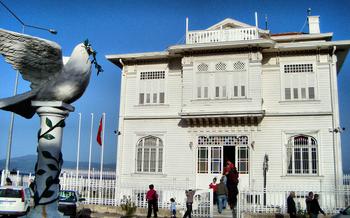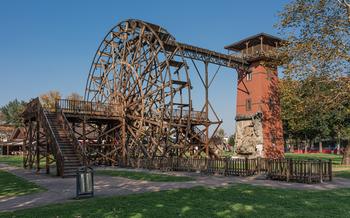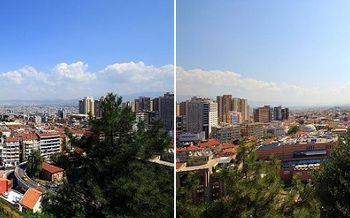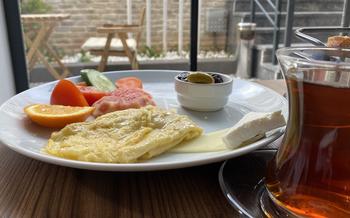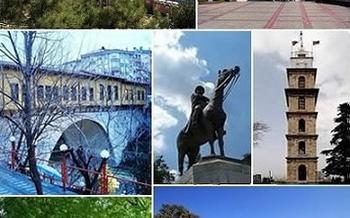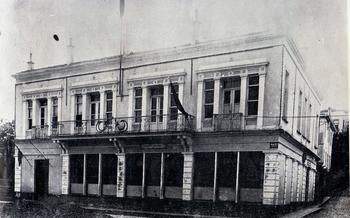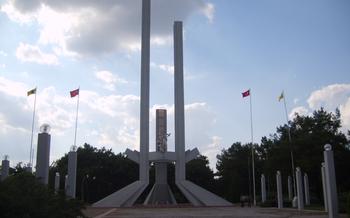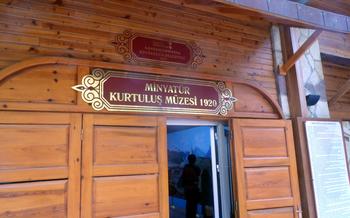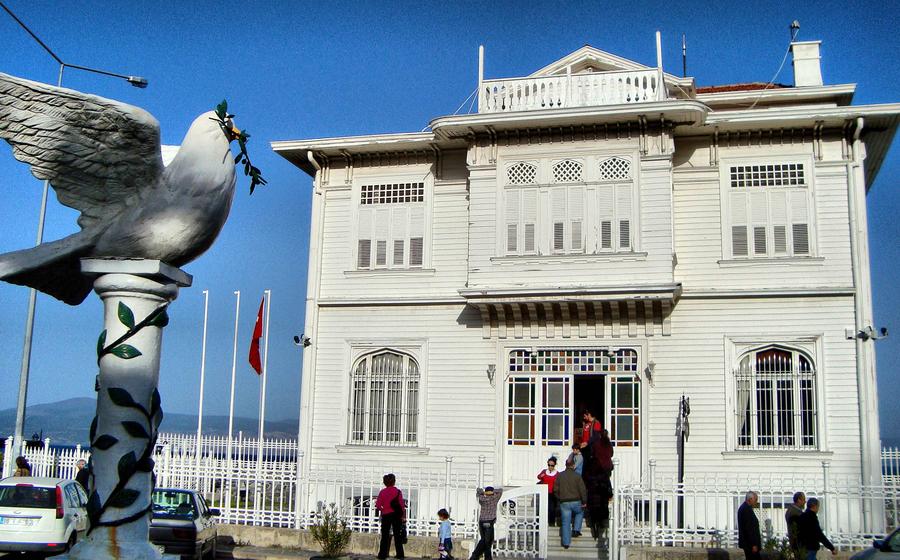
Mudanya Mütareke Museum
- Historical Significance:
- Location and Accessibility
- Museum Layout and Exhibits
- Historical Context and Background
- Personal Anecdotes and Experiences
- Visitor Tips and Practical Information:
- Historical Figures and Personalities
- Interactive Displays and Multimedia
- Educational Programs and Workshops:
- Historical Artifacts and Documents
- Architectural and Historical Significance
- Research and Academic Collaboration
- Museum's Role in Community Engagement
- Museum Shop and Souvenirs
- Insider Tip:
Historical Significance:
The Mudanya Mütareke Museum holds immense historical significance as it commemorates the signing of the Mudanya Armistice on October 11, 1922, which marked the end of the Greco-Turkish War of 1919-192This war was a crucial turning point in Turkish history, as it led to the establishment of the modern Turkish Republic under the leadership of Mustafa Kemal Atatürk. The museum serves as a poignant reminder of this pivotal event and its profound impact on shaping the course of Turkey's destiny.
The museum houses a rich collection of artifacts, documents, and photographs that narrate the events leading up to the armistice, the negotiations that took place, and the eventual signing of the agreement. Visitors can delve into the intricate details of the peace treaty, explore the roles played by key historical figures, and gain a deeper understanding of the political and military dynamics that shaped this critical period in Turkish history.
Preserving and commemorating this era is of utmost importance, as it not only honors the sacrifices made by those who fought for Turkey's independence but also serves as a valuable educational resource for future generations. The Mudanya Mütareke Museum stands as a testament to the resilience and determination of the Turkish people and their unwavering pursuit of sovereignty and self-determination.
Location and Accessibility
The Mudanya Mütareke Museum is conveniently located in the heart of Mudanya, a picturesque town on the Sea of Marmara, just a short distance from Bursa. It is situated within easy reach of other popular attractions in Bursa, making it an ideal stop on a comprehensive tour of the region.
To get to the museum, visitors can take advantage of the well-developed public transportation system in Bursa. Several bus lines and ferries connect Bursa city center with Mudanya, offering a scenic and affordable journey. Alternatively, visitors can opt for the comfort and flexibility of a private vehicle, as the museum is easily accessible by road and offers ample parking space.
For those who prefer a guided experience, organized tours are available from Bursa, combining a visit to the Mudanya Mütareke Museum with other historical sites in the vicinity. These tours typically provide transportation, a knowledgeable guide, and insights into the region's rich history and culture.
Museum Layout and Exhibits
The Mudanya Mütareke Museum is housed in a beautifully restored historical building that once served as the headquarters of the Turkish delegation during the armistice negotiations. The museum's layout is designed to take visitors on a chronological journey through the events leading up to and surrounding the signing of the Mudanya Armistice.
Upon entering the museum, visitors are greeted by a grand foyer that sets the tone for the rest of the experience. The foyer features a large-scale map of the region, showcasing the territorial changes that resulted from the armistice. From there, visitors can proceed to the main exhibition hall, which is divided into several sections.
Each section focuses on a different aspect of the armistice negotiations, with artifacts, documents, and interactive displays shedding light on the political and military developments of the time. Visitors can explore exhibits on the military campaigns, the diplomatic efforts, and the key figures involved in the process.
One of the highlights of the museum is the Peace Conference Room, which has been meticulously recreated to resemble its original appearance during the negotiations. Visitors can sit at the same table where the armistice was signed and imagine the tense atmosphere and high stakes that surrounded the delegates.
Throughout the museum, visitors will find a wealth of artifacts, including military uniforms, weapons, maps, photographs, and personal belongings of the delegates. These items offer a tangible connection to the past and help visitors gain a deeper understanding of the events that unfolded in Mudanya.
Historical Context and Background
The Mudanya Mütareke Museum stands as a testament to a pivotal moment in Turkish history, the Greco-Turkish War of 1919-192This war, fueled by territorial disputes and national aspirations, unfolded against the backdrop of the crumbling Ottoman Empire. Greece, seeking to expand its influence in the region, launched an invasion of western Anatolia in 1919, aiming to incorporate the predominantly Greek-populated areas into its territory.
Turkey, under the leadership of Mustafa Kemal Atatürk, fiercely resisted the Greek advance. Atatürk, a visionary military strategist and statesman, galvanized the Turkish people and organized a national resistance movement, known as the Turkish National Movement. The conflict raged on for over three years, witnessing intense battles and heavy casualties on both sides.
The war reached a critical juncture in 1922 when the Turkish forces, under Atatürk's command, launched a decisive offensive, culminating in the resounding victory at the Battle of Sakarya. This triumph shifted the balance of power in favor of Turkey, paving the way for negotiations and the eventual signing of the Mudanya Armistice on October 11, 192
Personal Anecdotes and Experiences
As I stepped into the Mudanya Mütareke Museum, I was immediately struck by a sense of awe and reverence. The museum's collection of artifacts and documents transported me back in time to a pivotal moment in Turkish history. I was particularly drawn to a handwritten letter by Mustafa Kemal Atatürk, the founder of the Turkish Republic. In it, he expressed his gratitude to the Turkish people for their unwavering support and determination during the war. The letter was a powerful reminder of Atatürk's leadership and vision for a modern, independent Turkey.
Another highlight of my visit was the interactive multimedia display that allowed me to explore the events leading up to and during the armistice negotiations. Through immersive storytelling and historical reenactments, I gained a deeper understanding of the political and military strategies employed by both sides. The interactive display brought the history to life and made the complex negotiations more tangible and relatable.
Reflecting on my experience at the Mudanya Mütareke Museum, I was reminded of the importance of understanding and preserving historical events. The museum serves as a testament to the resilience and determination of the Turkish people in their struggle for independence. It is a place where history comes alive, inspiring visitors to learn from the past and appreciate the sacrifices made by those who fought for a better future.
Visitor Tips and Practical Information:
Plan your visit to the Mudanya Mütareke Museum by checking its opening hours, which are typically from 8:30 am to 5:30 pm daily. Admission fees are nominal, and guided tours are available for a more in-depth experience. To avoid crowds and ensure a peaceful exploration, consider visiting during the weekdays or early in the morning. Combine your museum visit with other attractions in the vicinity, such as the nearby Mudanya Armistice Monument and the Mudanya Beach, where you can enjoy a stroll along the picturesque coastline. The museum offers basic facilities like restrooms and a small café for refreshments. Don't forget to visit the museum shop for souvenirs and publications related to the museum and Turkish history. Your purchase from the shop contributes to the museum's preservation efforts and helps sustain its educational mission.
Historical Figures and Personalities
The Mudanya Armistice was shaped by the actions and contributions of several key historical figures. İsmet İnönü, a prominent Turkish military commander and statesman, played a crucial role as the chief negotiator for the Turkish delegation. His strategic thinking and diplomatic skills were instrumental in securing favorable terms for Turkey.
Fevzi Çakmak, another renowned military leader, served as the Chief of the General Staff of the Turkish Army during the negotiations. His expertise and strategic insights were invaluable in shaping Turkey's military strategy and ensuring its successful implementation.
On the international front, General Charles Harrington, the commander of the Allied forces in Turkey, acted as the mediator during the armistice negotiations. His impartial approach and diplomatic skills helped facilitate the discussions and contributed to the eventual agreement.
These individuals, along with other Turkish delegates and foreign diplomats, played pivotal roles in shaping the outcome of the Mudanya Armistice. Their contributions reflected their dedication to their respective nations and their commitment to finding a peaceful resolution to the conflict.
Interactive Displays and Multimedia
The Mudanya Mütareke Museum features interactive displays and multimedia presentations that enhance the visitor experience and make history come alive. Visitors can engage with virtual reality exhibits that transport them back in time, allowing them to experience key moments from the Greco-Turkish War and the Mudanya Armistice negotiations. Interactive touchscreens provide detailed information about the historical figures, events, and documents on display. These multimedia elements not only engage visitors and make learning more enjoyable but also contribute to a deeper understanding of the historical events that shaped Turkey's destiny.
Educational Programs and Workshops:
The Mudanya Mütareke Museum offers a range of educational programs and workshops designed to engage students, groups, and families in learning about the historical significance of the Mudanya Armistice. These programs are led by experienced educators and historians who bring the events of the past to life through interactive activities, storytelling, and hands-on experiences.
One of the most popular programs is the "History Detectives" workshop, which invites participants to become historical detectives as they examine primary source documents, analyze artifacts, and solve puzzles related to the Mudanya Armistice. Another popular program, "The Art of Diplomacy," allows participants to role-play as diplomats from different countries, simulating the negotiations that led to the armistice.
The museum also offers guided tours for school groups, tailored to different age levels and curriculum requirements. These tours provide students with an immersive experience of the museum's exhibits, allowing them to learn about the historical context, key events, and the impact of the armistice on Turkish history.
Through these educational programs and workshops, the Mudanya Mütareke Museum plays a vital role in engaging younger generations in the study of history and heritage, fostering a deeper understanding of the past and its relevance to the present.
Historical Artifacts and Documents
The Mudanya Mütareke Museum houses a treasure trove of historical artifacts and documents that offer tangible insights into the events leading up to and during the Mudanya Armistice. Among the most notable exhibits are the original signed copies of the armistice agreement in Turkish, French, and English. These documents, with their intricate signatures and seals, hold immense historical significance as they represent the formal end of the Greco-Turkish War and the beginning of a new era for Turkey.
Other compelling artifacts include personal items belonging to key historical figures involved in the armistice negotiations, such as Mustafa Kemal Atatürk, İsmet İnönü, and Fevzi Çakmak. These objects, ranging from uniforms and medals to personal letters and photographs, provide a glimpse into the lives and personalities of these influential individuals.
One unique and poignant exhibit is a collection of letters written by Turkish soldiers during the war. These heartfelt messages, often written on scraps of paper or the backs of envelopes, convey the soldiers' hopes, fears, and longing for home. They offer a deeply personal and human perspective on the immense sacrifices made during the conflict.
The museum also displays a variety of weapons, maps, and other military equipment used during the war. These artifacts help visitors visualize the battles and strategies that shaped the course of the conflict. By showcasing these historical treasures, the Mudanya Mütareke Museum plays a crucial role in preserving and commemorating this pivotal period in Turkish history.
Architectural and Historical Significance
The Mudanya Mütareke Museum is housed in a magnificent historical building that holds significant architectural and historical value. Constructed in the 19th century, the building originally served as a summer residence for a wealthy Greek Orthodox merchant. Its elegant neoclassical façade, adorned with intricate carvings and moldings, reflects the architectural style prevalent during that era.
Over the years, the building underwent several renovations and alterations, adapting to different functions and purposes. In the early 20th century, it was transformed into a customs house, playing a crucial role in the bustling trade activities of the city. The building's strategic location on the waterfront made it a vital hub for goods and commerce.
In 1930, the building underwent a significant restoration and repurposing, transforming it into a museum dedicated to preserving the memory of the Mudanya Armistice. The restoration efforts aimed to maintain the building's original architectural features while adapting it to its new role as a historical repository.
Today, the Mudanya Mütareke Museum stands as a testament to the rich history of Bursa and the pivotal events that unfolded within its walls. The building's architectural elegance and historical significance add to the overall experience of visiting the museum, providing visitors with a glimpse into the past and the enduring legacy of the Mudanya Armistice.
Research and Academic Collaboration
The Mudanya Mütareke Museum actively collaborates with universities and research institutions to foster historical research and academic understanding. This collaboration allows the museum to access expertise, share knowledge, and contribute to the advancement of historical studies. Ongoing research projects and publications focus on various aspects of the Greco-Turkish War of 1919-1922, the Mudanya Armistice, and the broader history of Turkey during this period. The museum's partnership with academia ensures a rigorous and evidence-based approach to historical interpretation and enriches the museum's educational offerings. Visitors can benefit from the latest research findings and engage with scholars who are passionate about Turkish history.
Museum's Role in Community Engagement
The Mudanya Mütareke Museum actively engages with the local community and promotes historical awareness through various outreach programs, events, and workshops. The museum organizes lectures, seminars, and panel discussions on topics related to the Greco-Turkish War of 1919-1922 and the Mudanya Armistice. These events provide a platform for historians, scholars, and community members to share their knowledge and insights on this significant period in Turkish history.
The museum also hosts educational workshops and activities for students of all ages. These programs aim to introduce young people to the events leading up to the armistice and its impact on the course of Turkish history. Through interactive activities, storytelling, and hands-on experiences, the museum helps younger generations connect with the past and develop a sense of national pride.
Moreover, the museum collaborates with local cultural organizations and institutions to organize exhibitions, commemorations, and festivals that celebrate the region's rich history and heritage. These events bring together the community and foster a sense of shared identity and belonging. By actively engaging with the local community, the Mudanya Mütareke Museum plays a vital role in preserving and promoting the historical legacy of Bursa and Turkey.
Museum Shop and Souvenirs
The Mudanya Mütareke Museum boasts a well-stocked gift shop where visitors can purchase a variety of souvenirs and mementos to commemorate their visit and learn more about Turkish history. The shop offers an array of items, including books, postcards, replicas of historical artifacts, and traditional Turkish handicrafts. These souvenirs provide a tangible connection to the museum's exhibits and allow visitors to take a piece of history home with them.
Proceeds from the museum shop directly contribute to the museum's operations and preservation efforts, ensuring that this important historical site can continue to educate and inspire future generations. By purchasing a souvenir, visitors not only take home a unique keepsake but also support the museum's mission of preserving and promoting Turkish history.
Among the must-have souvenirs, visitors can find replicas of historical documents, such as the Mudanya Armistice agreement itself, or miniature models of significant landmarks associated with the Greco-Turkish War. Traditional Turkish handicrafts, such as hand-woven carpets, pottery, and jewelry, make for meaningful and authentic souvenirs that represent the rich cultural heritage of the region.
For those looking for a truly unique memento, the museum shop offers limited-edition items or exclusive collaborations with local artisans. These special souvenirs are often inspired by the museum's collection and provide a one-of-a-kind way to remember the visit. Whether it's a book about the history of the armistice, a replica of a historical artifact, or a piece of traditional Turkish craftsmanship, the museum shop offers something for every visitor.
Insider Tip:
For an immersive experience, plan your visit to the Mudanya Mütareke Museum to coincide with the annual Armistice Day commemorations held on October 11th. This special event features reenactments, parades, and cultural performances that bring history to life. It's a unique opportunity to witness the local community's deep connection to their heritage and celebrate the legacy of the Mudanya Armistice. Check the museum's website for details on the upcoming Armistice Day program and make your visit even more memorable.
